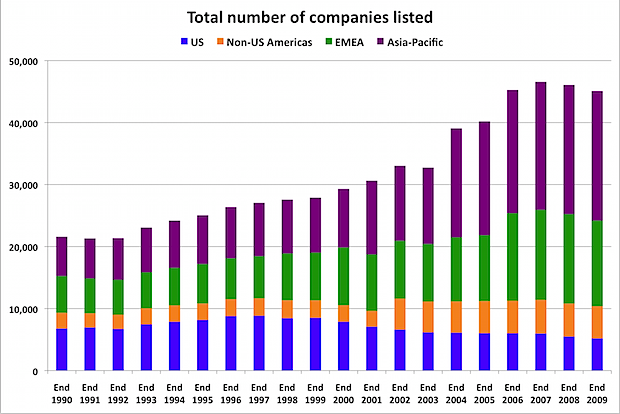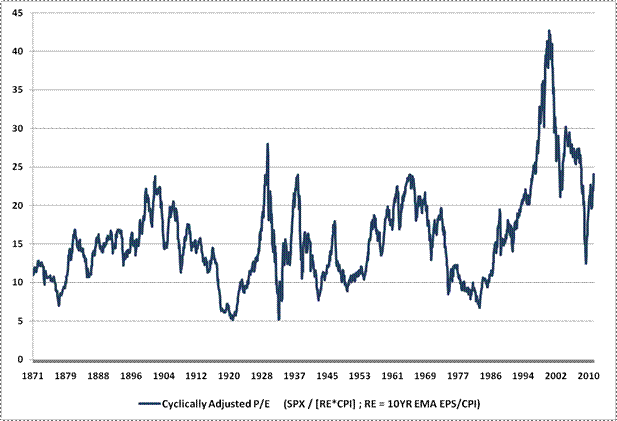There has been an interesting debate going on amongst some of my fellow bloggers in recent days about the meagre future return potential of stocks in developed markets. The return prospects for the US look particularly cloudy. And this is important, because as Sell on News noted today, the US still dominates the global markets in terms of market capitalisation.
But by other indicators, the importance of the US has been in a steady decline for a while now. The chart below from Felix Salmon shows that in terms of the number of companies listed, the Asia Pacific region already dwarfs the US. In fact, even EMEA (Europe, Middle East and Africa) does.

As Salmon says:
US listings now account for only about 10% of all listed companies globally — that’s significantly less than America’s share of global GDP, which is closer to 20%. Even as the US is moving from public to private, or at the very least from many public companies to fewer public companies, the rest of the world is still moving fast in the opposite direction.
Looking at this chart, it seems to me that anybody with the bulk of their equity holdings in US companies is clearly missing out on something important.
And this point is even more relevant, because after their massive rally from the depths of 2008, US stocks today do not look particularly cheap.
The chart below from John Hussman of Hussman Funds illustrates this point.

As Hussman explained earlier this month:
Last week, the S&P 500 Index ascended to a Shiller P/E in excess of 24 (this “cyclically-adjusted P/E” or CAPE represents the ratio of the S&P 500 to 10-year average earnings, adjusted for inflation). Prior to the mid-1990’s market bubble, a multiple in excess of 24 for the CAPE was briefly seen only once, between August and early-October 1929.
Of course, we observed richer multiples at the heights of the late-1990’s bubble, when investors got ahead of themselves in response to the introduction of transformative technologies such as the internet. After a market slide of more than 50%, investors again pushed the Shiller multiple beyond 24 during the housing bubble and cash-out financing free-for-all that ended in the recent mortgage collapse.
And here we are again.
This is not to say that we can rule out yet higher valuations, but with no transformative technologies driving the economy, little expansion in capital investment, and ongoing retrenchment in consumer balance sheets, I can’t help but think that the “virtuous cycle” rhetoric of Ben Bernanke is an awfully thin gruel by comparison.
We should not deserve to be called “investors” if we fail to recognize that valuations are richer today than at any point in history, save for the few months before the 1929 crash, and a bubble period that has been rewarded by zero total return for the S&P 500 since 2000. Indeed, the stock market has lagged the return on low-yielding Treasury bills since August 1998. I am not sure that even members of my own profession have learned anything from this.
…we presently estimate that the S&P 500 is priced to achieve an average total return over the coming decade of just 3.15% annually.
In other words, US large cap stocks might barely outpace inflation over the next decade. All of this presents a bit of a dilemma for investors. With interest rates as low as they are today, they can only go up over the coming decade. That means that bond returns are likely to be subpar as well. Commodities are looking fairly overheated. And emerging markets like China look like a good bet over the long term, but there are likely to be some wrenching adjustments along the way.
Diversification and a sensible long-term asset allocation plan look more important than ever.
(note to Australians: 5 different investment properties does not equal diversification)